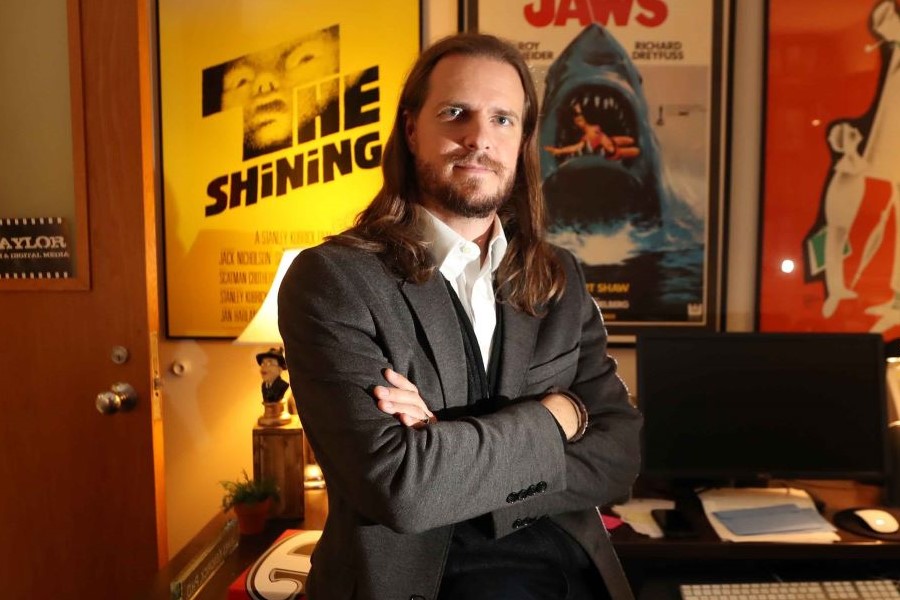Scary Movies for the Faint of Heart
Baylor horror film expert lists 10 movies that give thrills without too much of the chills

(Prostock-Studio)
WACO, Texas (Oct. 5, 2023) – Spooky season is upon us. Those who love a good scary movie have a multitude of choices to get in the spirit of the season. But for those with a slightly weaker constitution, what are the options for a good old-fashioned scary movie.
Hollywood film historian and horror film expert James Kendrick, Ph.D., professor of film and digital media at Baylor University, says many people tend to associate horror with gore, but that is not always the case.
“There is a distinction we can make between ‘horror’ and ‘terror.’ Horror tends be bloodier and more visually unrestrained—what we often think of when we think of gory horror films. Terror, on the other hand, is more emotional and spiritual and engages our fears and anxieties without drowning us in blood and guts,” Kendrick said.
Fear “works” because it is able to play with human empathy. By using current situations, directors and producers can generate characters and settings that their audience can relate to.
“The best films, the ones that really stand out in our memory, are the ones that we connect with emotionally through characters and that we sense have a deeper purpose than just causing anxiety,” Kendrick said.
To help scaredy cats find the Halloween film right for them, Dr. Kendrick provides his Top 10 list of scary movies that even the faint of heart can enjoy.
1. Vampyr (1932)
Danish filmmaker Carl Theodor Dreyer’s Vampyr, a masterfully evocative and unsettling horror film, failed to find the audience it deserved in the early 1930s because its challenging tone and unorthodox structure was upstaged by Tod Browning’s more conventional approach to the genre in Dracula (1931). The pervasive presence of the supernatural makes for an evocative cinematic experience and may also be why audiences initially rejected it as difficult and confusing. While there is a vampire in the film, Dreyer draws from all kinds of supernatural lore, giving us shadowy figures who drift throughout the film; strange, inexplicable characters who enter and leave the story without explanation; and a constant merging of waking reality and dream states.
2. The Innocents (1961)
Jack Clayton’s The Innocents, a brilliantly unsettling adaptation of Henry James’s 1898 novella The Turn of the Screw, is one of the best-looking horror films you’ll ever see. Its deep-focus black-and-white CinemaScope imagery is entrancing, although never at the expense of the tension and chills that come with things that go bump in the night. Rather, the beauty enhances the dread by intensifying our sense of how feeble even the most luminous of surfaces can be in hiding the horrors beneath, which is appropriate for a film awash in Freudian subtext (the screenplay was written by Truman Capote while he was researching In Cold Blood).
3. Kwaidan (1964)
An adaptation of four Japanese legends and myths with horrific undertones, Kwaidan is a visually ravishing film that employs dazzling color palettes and carefully composed widescreen photography to draw us into its entirely supernatural world; the interweaving of expansive sets, painted backdrops and complex lighting schemes lends everything an unshakably otherworldly quality. Director Masaki Kobayashi was best known as a purveyor of realistic contemporary stories with explicit social themes, and his use of horror and the paranormal is notably romantic, infused with great passion and intense human emotions that emerge out of the characters’ interactions with various ghosts and spirits.
4. Invasion of the Body Snatchers (1978)
Philip Kaufman’s reworking of Don Siegel’s B-movie classic of the same title from 1956 is a template for how to do a horror remake right. Rather than simply exploiting a familiar title, Kaufman’s film takes the basic premise from Siegel’s film and reimagines it for a different era and a different place, thus making the material entirely new while remaining rooted in the fundamental human fear of losing one’s identity. While Siegel’s film played as a paranoid extension of the McCarthy era, Kaufman’s version satirizes the self-absorbed absurdity of cosmopolitan San Francisco in the Carter years, where self-help gurus, Turkish bath houses and a general air of personal self-indulgence conspire to make it all the more difficult to differentiate humans from pod people. Kaufman gives the film a great neo-noir feel with blankets of trapezoidal shadows and canted camera angles, turning it into one of the great sci-fi horror shows, a movie that gooses you with its premise, makes you laugh and jump and ultimately leaves you with something you can’t quite shake.
5. The Vanishing (1988)
George Sluizer’s The Vanishing (Spoorloos) doesn’t defy rationality, as most horror films do, but rather turns rationality itself into an instrument of horror. The film’s monster, a seemingly harmless professor of science, does not commit evil acts because of some inherent nature or uncontrollable urge. Rather, he commits them for the worst reason of all: Because he can. The Vanishing is perhaps most disturbing in how it depicts the methodical, exacting nature of evil. It is trained and practiced, thought out and rehearsed. (Side note: Avoid at all costs the 1993 American remake. Despite also being directed by Sluizer, it is an inferior film with a completely different and much less effective ending.)
6. The Blair Witch Project (1999)
An inexpensive independent feature that helped launch the “found footage” craze, The Blair Witch Project takes the form of a pseudo-documentary made by three Maryland film students who disappeared while researching the local legend of the Blair Witch. The movie purports to be the recovered footage from their High-8 video and 16mm cameras that explains what happened to them. Although it was shot over eight days with the actors doing most of the camerawork themselves, this is a meticulously put together horror film. It is never graphically violent, but it is increasingly gripping. Once the students get lost in the woods, and strange things begin happening at night, the movie grows in stomach-churning intensity until the shocking, inevitable conclusion.
7. The Others (2001)
Alejandro Amenábar’s The Others is a small masterpiece of atmosphere and tone that slowly and methodically works its way through a classically elegant, yet gut-wringing ghost story with a brilliantly conceived twist ending that turns the tables on everything that came before it. Amenábar demonstrates a commanding sense of how everything at his disposal—light and dark, noise and silence, steady camera moves and sudden pans—can be used to ratchet up the tension to nearly unbearable heights. The film is replete with brooding dread and lengthy moments of sustained tension, largely avoiding the easy sledgehammer approach of shocking images and digital special effects.
8. Take Shelter (2011)
In Jeff Nichols’s Take Shelter, Michael Shannon gives an outstanding performance as a blue-collar Midwestern family man whose increasingly intense nightmares about an approaching storm begin to haunt his waking hours and compel him to construct an elaborate storm shelter in the field behind his family’s home. The power of Shannon’s performance is in the way he conveys his character’s gnawing fear of mental breakdown and the sadness that overwhelms him as he compulsively goes about work that he knows may very well be destroying him and his family. Shannon’s performance is matched with equal intensity and nuance by the work of writer/director Jeff Nichols, who displays an uncanny understanding of the manner in which small, naturalistic details can add up to an overwhelming sense of anxiety and horror.
9. Warm Bodies (2013)
The protagonist of Warm Bodies is a zombie—a lumbering dead-eyed corpse who nevertheless is completely alive inside his own mind and aware of his absurd situation. Accustomed as we are to seeing zombies as thoughtless ghouls or metaphors waiting to be filled with social significance, encountering one who is flooded with thoughts, emotions and existential conflict over his predicament is both amusing and moving. And, as unlikely as it sounds, Warm Bodies is first and foremost a zombie-human romance, and a tender, poignant one at that. Writer/director Jonathan Levine strikes an almost perfect tonal balance, playing the film’s horrific elements straight (or as straight as he can within the confines of a PG-13 rating) while also drawing out indelible bits of dark humor and making the growing connection between a girl and a zombie not only plausible, but surprisingly moving.
10. A Quiet Place (2018)
The unsettling effectiveness of John Krasinski’s gripping horror-thriller A Quiet Place derives from its fundamental inversion of the typical relationship in the horror genre between silence and death. Here, silence is absolutely essential to life, and sound of virtually any kind is a guarantee of death at the claws and teeth of mostly unseen monstrosities that have taken over the world. Krasinski displays a striking sense of how horror films work (despite claiming in interviews that, as a self-described “fraidy cat,” he has previously had no interest in the genre), and he manages to evoke and sustain an immense sense of dread that keeps us in a rarefied state of heightened attention; it is the kind of film that makes you afraid to let your guard down.
ABOUT JAMES KENDRICK, PH.D.
James Kendrick, Ph.D., professor of film and digital media in Baylor University’s College of Arts & Sciences, focuses his primary research interests on post-Classical Hollywood film history, violence in the media, cult and horror films, media censorship and regulation and cinema and new technologies. He has authored three books: Darkness in the Bliss-Out: A Reconsideration of the Films of Steven Spielberg; Hollywood Bloodshed: Violence in the 1980s American Cinema and Film Violence: History, Ideology, Genre. In addition to this, he is the film and video critic for the website Qnetwork.com. Kendrick is a member of the Society for Cinema and Media Studies, the University Film and Video Association and the Online Film Critics Society.
ABOUT BAYLOR UNIVERSITY
Baylor University is a private Christian University and a nationally ranked Research 1 institution. The University provides a vibrant campus community for more than 20,000 students by blending interdisciplinary research with an international reputation for educational excellence and a faculty commitment to teaching and scholarship. Chartered in 1845 by the Republic of Texas through the efforts of Baptist pioneers, Baylor is the oldest continually operating University in Texas. Located in Waco, Baylor welcomes students from all 50 states and more than 100 countries to study a broad range of degrees among its 12 nationally recognized academic divisions.
ABOUT THE COLLEGE OF ARTS & SCIENCES AT BAYLOR UNIVERSITY
The College of Arts & Sciences is Baylor University’s largest academic division, consisting of 25 academic departments in the sciences, humanities, fine arts and social sciences, as well as 11 academic centers and institutes. The more than 5,000 courses taught in the College span topics from art and theatre to religion, philosophy, sociology and the natural sciences. The College’s undergraduate Unified Core Curriculum, which routinely receives top grades in national assessments, emphasizes a liberal education characterized by critical thinking, communication, civic engagement and Christian commitment. Arts & Sciences faculty conduct research around the world, and research on the undergraduate and graduate level is prevalent throughout all disciplines. Visit the College of Arts & Sciences website.
